Resolving Common PayPal Card Reader Issues
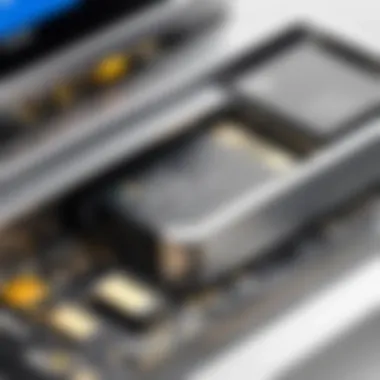
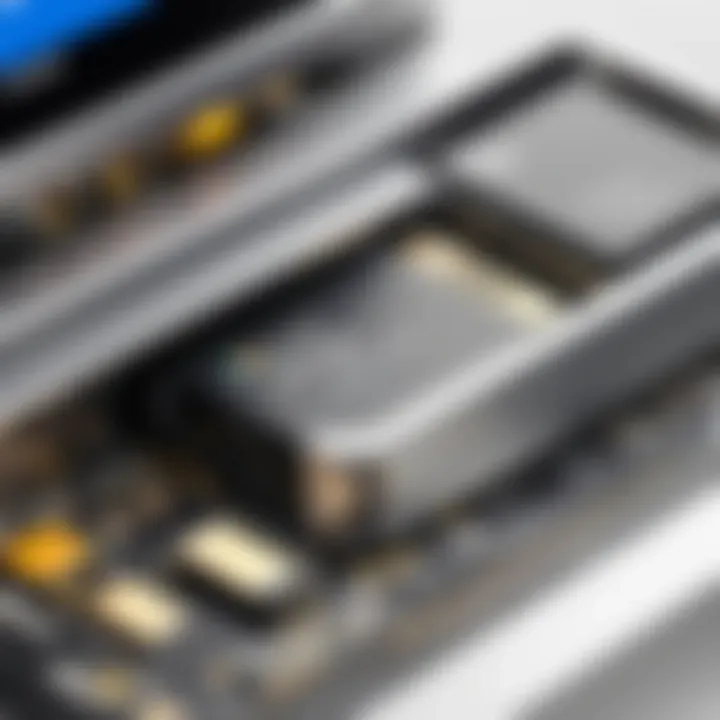
Intro
Encountering trouble with a PayPal card reader can feel like finding a pebble in your shoe—annoying and disruptive, especially when you’re trying to complete transactions smoothly. Whether you're a seasoned professional handling high volumes of sales or a small business owner making a few occasional sales, knowing how to effectively troubleshoot issues surrounding your card reader is crucial.
In this guide, we will delve into the common problems users experience with PayPal card readers, offering targeted solutions that can restore functionality and optimize your payment processing experience.
Software Overview
Understanding the software that powers your PayPal card reader is vital for troubleshooting. The software, which is typically pre-installed or easily downloadable, performs several key functions that ensure seamless transactions. Its primary purpose is to bridge communication between the card reader and your mobile device or computer—processing payment data securely in the process.
Purpose and function of the software
The software facilitates real-time transaction processing, allowing you to accept payments quickly and efficiently. It manages the data flow between the card reader and the PayPal payment platform while ensuring that sensitive information remains secure throughout the process.
Key features and benefits
- Real-time Payment Alerts: Get immediate notifications when a transaction goes through, helping you stay on top of your sales.
- User-Friendly Interface: Designed with simplicity in mind, the software allows for straightforward navigation, even for those who may not be tech-savvy.
- Versatile Payment Options: Supports a range of payment types including credit, debit, and digital wallets, making it adaptable to modern consumer preferences.
- Integrated Inventory Management: For those businesses that require stock tracking, the software can help manage sales and inventory in one place.
- Secure Data Encryption: The software employs advanced encryption methods to safeguard customer information during transactions, which is a top priority for any business.
Installation and Setup
Setting up your PayPal card reader requires a straightforward approach to ensure that everything operates smoothly from the get-go. Below, we outline the essential steps and requirements to get your device up and running.
System requirements
Before diving into the installation, it’s important to check that your device meets the necessary specifications. You'll need:
- A compatible smartphone or tablet running iOS or Android.
- Stable internet connection, whether through Wi-Fi or mobile data.
- Sufficient storage space on your device to download the required app.
Installation process
- Download the PayPal Here app: Go to either the App Store or Google Play Store on your device and search for the PayPal Here application. Tap ‘Download’ to install.
- Create or log into your PayPal account: After installation, open the app and sign in or create a new account if you don’t already have one.
- Connect your card reader: Depending on your model, follow the specific instructions provided in the app to pair your card reader with your device, ensuring Bluetooth is enabled.
- Finalize your settings: Adjust settings as needed, such as adding sales tax or connecting to your inventory list.
"A well-set-up card reader can make all the difference between a sale and a lost opportunity."
Once the installation is complete and the software is configured, you’ll be better positioned to handle any potential issues that arise during transactions.
Understanding the underlying software functions and correctly setting up the device are fundamental steps in troubleshooting. Keep in mind that recognizing problems early allows for quicker resolutions, which ultimately enhances your overall payment processing capabilities.
Understanding the PayPal Card Reader
When it comes to processing payments on the go, PayPal Card Readers have emerged as a game changer, making it easier for small businesses and freelancers to accept card payments anywhere. This section aims to provide insight into what a PayPal Card Reader is, its significance, and why understanding its functionalities is crucial for an effective payment experience.
Prologue to the PayPal Card Reader
In essence, PayPal Card Readers are compact devices designed to process card payments securely and swiftly. From busy cafes to flea markets, these readers bridge the gap between customers and sellers, allowing transactions to happen seamlessly. Users often find themselves in scenarios where they need fast and efficient payment solutions, and this is where these little devices shine. Whether you’re a seasoned vendor or a newbie just dipping your toes into running a business, grasping how these readers work not only enhances user experience but also builds customer trust.
I remember a time when my friend, who ran a small food stall, faced hiccups during a bustling weekend market. The surge of customers eagerly awaiting their orders was a sight to behold. However, her card reader misbehaved, resulting in frustration and long wait times. If only she had better understood her device and how to troubleshoot such issues, it could have saved her a world of trouble.
Key Features and Functions
The functionality of the PayPal Card Reader is packed with features designed to cater to various business needs. Here are a few noteworthy aspects:
- Compatibility: These devices can work with various card types, including credit, debit, and even some mobile wallet options. This makes it convenient for users who prefer different payment methods.
- Portability: The sleek design means it fits easily in one’s pocket, making it ideal for business owners who are always on the move.
- Secure Transactions: Utilizing encryption, these readers ensure that customer data is handled safely, which is a non-negotiable in today's digital age. Security breaches can tarnish a brand's reputation, so this feature is paramount.
- Integrated Services: The card readers come with an app that lets businesses track sales, analyze customer data, and manage inventory efficiently. It provides a complete package, making life easier for small business owners who wear multiple hats.
Understanding these key features will not only enable users to utilize their card readers more effectively but also help them convey the benefits to potential customers, thus enhancing overall customer satisfaction.
"Being informed about your tools can turn a stumbling block into a stepping stone."
In summary, at the crux of a successful payment processing experience lies the PayPal Card Reader. Knowing its functionalities helps in handling common issues preemptively, ensuring smoother transactions and happier customers. Whether it's about getting familiar with features or troubleshooting unexpected hiccups, knowledge is the first step towards mastery.
Common Problems with PayPal Card Readers
In the ever-evolving landscape of modern payments, encountering issues with your PayPal card reader is not uncommon. Understanding these common problems is the first step towards ensuring a seamless transaction experience. Addressing these matters promptly doesn't just save time; it fosters customer trust and supports an efficient workflow for businesses utilizing this payment method.
Card Reader Not Recognizing Cards
One of the most frustrating issues a user can face is a card reader that fails to recognize chips and magnetic strips. This particular dilemma can arise from various factors, including dirt or debris on the reader, damage to the card, or even firmware issues within the reader itself. When the reader doesn’t respond or provides an error message upon card insertion, customers may experience discomfort, leading to losses in confidence and sales.
To mitigate this issue, ensure the following:
- Inspect the Reader: Check for any foreign objects lodged in the card slot, including dust or grime.
- Examine the Card: Look closely at the card. If it's scratched or damaged, that might be the root of the problem.
- Firmware Update: Sometimes, a simple update could resolve any bugs that inhibit recognition.
Connectivity Issues
Many users report challenges with connectivity, particularly with Bluetooth-enabled devices. Problems may arise due to various reasons, including interference from other wireless devices or insufficient range between the card reader and the mobile device. These connectivity hiccups can lead to delays in processing transactions, frustration for both the merchant and the customer, and even possible loss of sales.
To troubleshoot connectivity issues, consider the following actions:
- Check Distance: Ensure that the mobile device is within a reasonable range of the card reader.
- Bluetooth Reset: Turn off and then on the Bluetooth on both devices to refresh the connection.
- Interference Checks: Move away from other electronic devices to reduce potential interference.
Low Battery or Power Problems
Power problems also emerge as a prevalent hindrance among card readers. When the battery is low or there is an issue with the power supply, users may find themselves unexpectedly unable to process payments. There are common signs of power-related issues, such as an illuminated battery indicator or sudden shutdowns during transactions. For a business reliant on quick payments, such troubles can be a significant setback.
To tackle battery management, take note of these points:
- Battery Level Monitoring: Frequently check battery levels, especially before busy hours.
- Proper Charging Techniques: Follow the manufacturer's guidance on charging practices. Overcharging or improper cabling can ruin battery life.
- Alternative Power Sources: Having spare power banks or chargers handy can prevent downtime due to low battery issues.

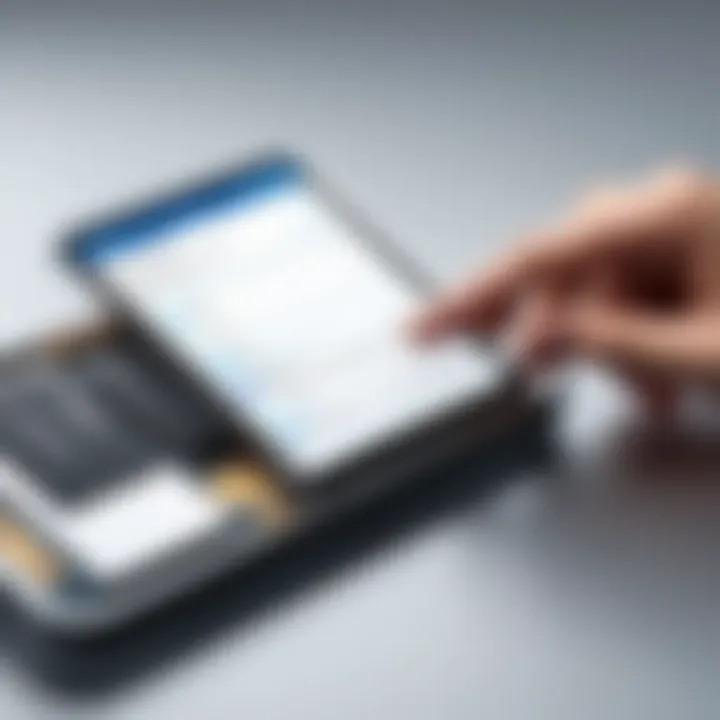
The art of troubleshooting often lies in simple observations and preventive measures.
Addressing these vital problems not only increases your operational efficiency but also enhances customer satisfaction. Remember, a well-functioning payment system is the backbone of transactions in today’s fast-paced market.
Initial Troubleshooting Steps
When it comes to addressing issues with your PayPal card reader, taking a methodical approach through initial troubleshooting steps is crucial. These preliminary actions often serve as the backbone of your strategy to restore functionality. Understanding the significance of these steps can drastically reduce downtime and optimize your transaction experience.
Sometimes, users might jump straight into more complex fixes without checking the basics. However, simple checks can save you time and effort. Start with the right footing—this is like checking your compass before embarking on a hike; one small oversight in the initial phases can lead you far off the beaten track.
Checking Hardware Connections
The first thing to do is to ensure that all hardware connections are secure. This means inspecting both the card reader and the mobile device it connects to. Loose and improperly connected wires can be the culprit behind many issues. Take a moment and verify that the cables are plugged in tightly.
Here are key points to consider:
- Confirm if the card reader is fully charged or connected to power if it requires a source.
- Ensure that the connection ports on the device and reader are clean and free from debris. Dust bunnies can easily sneak in and disrupt functionality.
- Sometimes, it helps to unplug and then replug the device, akin to giving it a reset. This can help refresh the connection instantly.
Restarting the Card Reader
If after checking connections the issue persists, then a simple restart might do the trick. It’s astounding how many tech problems can be solved by giving your device a little break. Restarting the card reader doesn’t just refresh the current state; it can also clear any temporary glitches that may have built up. To do this effectively:
- Power off the device completely. Wait for a few moments, say about 10-20 seconds, then turn it back on.
- If it’s connected to a mobile device, consider restarting that too. It may seem trivial, but rebooting often resolves various sync and app-related issues.
Inspecting User Guide and Documentation
Don’t underestimate the power of the user manual that came with your device. It might be easy to toss it aside in a fit of frustration, but this document often contains valuable insights. Sometimes, you might stumble upon info that’s just the ticket to solving your problem.
Consider these aspects when digging into the guide:
- Common Troubleshooting Tips: Most manuals include a section dedicated to fixing frequent user problems. These hints could provide you with tailored solutions specific to your model.
- Visual References: Diagrams and photos can help you understand how to properly connect devices or identify parts that might be malfunctioning. If diagrams can make assembling IKEA furniture manageable, they can surely assist with tech.
- Always check online resources such as forums or customer support sections. Sites like Reddit often have community-driven solutions from users who’ve faced similar predicaments.
Utilizing these initial troubleshooting measures is both practical and efficient. No one enjoys dealing with technical hiccups, but with a calm approach and a touch of patience, you can tackle issues surrounding your PayPal card reader like a pro.
Dealing with Connectivity Issues
When it comes to using your PayPal card reader, connectivity is often the linchpin that holds everything together. Without a solid connection, your device may as well be a paperweight. Whether you're making a sale at a bustling market or processing payments in your small business, any hiccup in your connectivity can lead to lost sales and frustrated customers. As such, addressing connectivity issues not only enhances the functionality of the card reader but also maximizes your potential revenue stream. Understanding how to manage these issues effectively can make a world of difference for business owners trying to maintain a smooth operation.
Resetting Bluetooth Connection
Bluetooth connectivity is a common method for linking your PayPal card reader to mobile devices. If you're experiencing dropouts or if the card reader doesn't show up on your device's list, resetting the connection might be your best bet. Start by turning off Bluetooth on your mobile device, then power off your card reader. Wait a moment, and then power the card reader back on. After that, re-enable Bluetooth on your mobile device.
Here’s a simple checklist to follow:
- Turn off Bluetooth on your mobile device.
- Power down the card reader completely.
- Wait for 10-15 seconds.
- Power on the card reader.
- Turn Bluetooth back on on your mobile device.
- Attempt to re-pair the devices.
If this doesn’t work, try forgetting the device from your Bluetooth settings, then re-pairing it as if it’s a brand new connection. It’s surprising how often a simple reset can resolve persistent connectivity headaches.
Checking Mobile Device Settings
Beyond Bluetooth itself, the settings on your mobile device can play a pivotal role in ensuring a stable connection with your PayPal card reader. Sometimes, updates or configurations can inadvertently block the device or lead to connectivity issues. Start by checking if your device is set to "Do Not Disturb," which can hinder notifications from the payment application necessary for processing transactions.
Here’s what to review:
- Make sure Bluetooth is enabled.
- Disable Do Not Disturb mode.
- Examine app permissions specific to location and data access, which are crucial for functioning.
- Check for any VPN settings that might be interfering with the connection.
You want to make your device a friendly companion to your PayPal card reader. Once you have sorted settings, if issues persist, consider whether your phone's software needs an update. Sometimes, an old operating system can create compatibility hiccups.
Updating App and Firmware
In the tech world, standing still is as good as moving backwards. Regularly updating your software—both the PayPal app and the firmware on your card reader—ensures that you have access to the latest features and security patches. Outdated software can lead to connectivity issues, functionality limitations, and increased vulnerability to security threats.
Here’s how to do that effectively:
- Check your mobile app store for any pending updates to the PayPal app. Updating can bring crucial fixes, enhancing overall performance.
- Check the firmware version of your card reader as specified in the user manual. Many devices offer an update feature that allows you to check for available updates directly.
- After updating, restart both your mobile device and the card reader, as this often solidifies the updates, ensuring everything runs smoothly.
By keeping everything current, you equip yourself with more reliable tools that enhance your payment processing capabilities.
Remember, connectivity is key. A smooth connection means a smoother sale!
Battery Management and Power Solutions
Battery management plays a critical role in ensuring that your PayPal card reader functions smoothly and efficiently. A faulty or dead battery can lead to disruptions during transactions, creating frustration for both the user and the customer. Having a clear understanding of how to manage power effectively not only extends the lifespan of the device but also sustains the reliability needed for seamless payment processing. Therefore, addressing battery-related issues proactively can prevent more significant concerns down the road.
Identifying Battery Issues
Recognizing the signs of battery problems is the first step in effective troubleshooting. There are several indicators that your card reader may be experiencing battery troubles:
- Device not powering on: If the card reader fails to turn on at all, this is often a clear signal that the battery is either dead or malfunctioning.
- Unusual flashing lights: If the LED indicators are blinking in unexpected patterns, this may suggest a low battery or a need for troubleshooting.
- Frequent disconnections: A battery that is failing to hold a charge might cause the device to lose connectivity intermittently.
To confirm these issues, consider running a battery diagnostic test if your significant model supports it, or just monitor how long the battery lasts during regular use.
Charging the Device Properly
Charging the PayPal card reader correctly is fundamental for maintaining battery health. Improper charging practices can lead to a decreased battery lifespan. Here are some tips to enhance your charging routine:
- Use the approved charger: Always utilize the charger that comes with your card reader. Third-party chargers may not provide the correct voltage or current needed.
- Charge fully before first use: If your card reader is brand new, ensure to charge it fully before using it for the first time. This helps in calibrating the battery properly.
- Avoid overcharging: Keeping the device plugged in once it's fully charged can lead to battery degradation over time. Unplug the charger to prevent this issue.
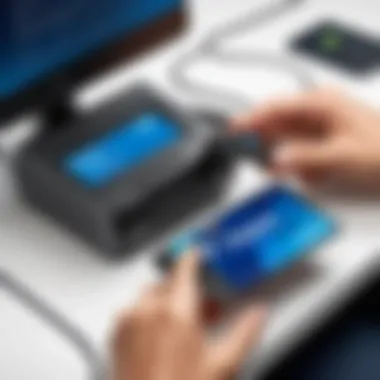
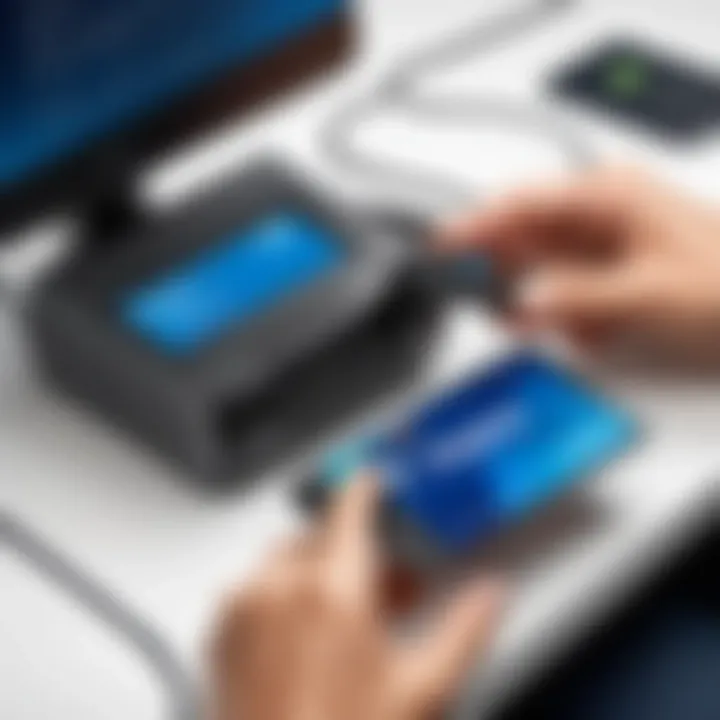
Following these guidelines will help you get the most out of your battery and reduce the likelihood of unexpected issues during transactions.
Alternative Power Solutions
If you frequently encounter power issues that hinder your payment processes, consider exploring alternative power solutions. A well-charged battery is vital, but sometimes external factors can impact performance.
- Power banks: Carry a portable power bank to recharge the device on-the-go, especially during long events or when access to outlets is limited.
- AC adapters: In situations where wireless power seems unreliable, having an AC adapter or direct power source can help maintain operation at all times.
- Battery replacements: If after proper management the battery still fails, it may be wise to consider a replacement to ensure consistent performance.
Remember: Staying ahead of battery management can save time and trouble later. Addressing these small issues proactively keeps your PayPal card reader running smoothly and ensures you can focus on your business activities without interruptions.
Examining Software and Application Settings
In the realm of troubleshooting PayPal card readers, diving into software and application settings is paramount. Often, the hardware issues we encounter may not stem from the physical device but rather from the software environment in which it operates. This exploration equips users with the tools not just to resolve existing problems but to prevent them in the future. Addressing software issues can lead to smoother transactions and more reliable performance, making it an essential part of any troubleshooting guide.
Updating PayPal App
Keeping the PayPal app updated is not just a suggestion; it's a necessity. Each app update often comes packed with fixes for bugs that may disrupt your payment process. Missing out on these updates can leave users grappling with unresolved issues, like error messages that pop up or connectivity glitches that make transactions frustrating. To update the PayPal app:
- Open your device’s app store.
- Tap on 'Updates' or simply search for PayPal.
- If an update is available, download the latest version.
This simple routine can dramatically enhance the functionality of your card reader, ensuring compatibility with the latest payment processing standards and security features.
Adjusting App Permissions
App permissions can be a hidden cause of malfunction. If the PayPal app does not have the necessary permissions, it may not function as intended. For instance, the app might need access to your device’s Bluetooth, camera, or storage, which are critical for card reading and processing transactions. To adjust these settings:
- For Android:
- For iOS:
- Open Settings.
- Tap on 'Apps' and find PayPal.
- Select 'Permissions' and enable necessary permissions.
- Go to Settings.
- Scroll down to PayPal.
- Enable the required permissions.
By ensuring that the app has the permissions it requires, users can mitigate the risk of error messages or connection failures. It’s a small step that can yield significant dividends in user experience.
Testing with Other Payment Apps
Sometimes, looking beyond PayPal can shed light on issues that seem stubborn. Testing the card reader with alternative payment applications can help identify whether the problem lies within the PayPal app or the card reader itself. Here’s how to approach it:
- Download another trusted payment app, like Square or Stripe.
- Pair your card reader to the new app as per its setup instructions.
- Attempt a transaction.
If the card reader works with another application, it could suggest that the issue is specific to the PayPal app. In this case, consider reinstalling it or reaching out to PayPal support for further assistance.
"In many cases, it's not just a single culprit behind the issue; multiple settings could play a role, and each needs a glance."
By understanding and examining software and application settings, users can navigate the intricate web of technology that keeps their PayPal card readers functioning smoothly.
Advanced Troubleshooting Techniques
In situations where basic troubleshooting steps have failed, advanced techniques become pivotal. These methods provide users with deeper insights into underlying problems. Grasping these strategies is important as they allow users to narrow down issues that may not be immediately apparent. With a systematic approach, users can improve their chances of resolving more complex faults, ensuring smoother operations overall.
Performing a System Reset
A system reset often serves as the first line of defense in tackling stubborn issues that persist due to settings or temporary glitches. To perform a system reset on your PayPal card reader, you will typically need to press and hold the power button for around ten seconds. This action clears the memory and resets any active functionalities that might be causing hiccups.
Exploring this technique can yield benefits such as restoring connectivity and minimizing unexplained performance drops. However, it is worth noting that resetting doesn’t always guarantee instant relief. This technique, while straightforward, is undoubtedly a necessary step in the troubleshooting arsenal. Always refer to the user manual for your specific model to ensure that the reset process aligns with the manufacturer's guidelines.
Testing with Different Devices
Shifting gears and testing the card reader with other devices can provide distinctive clarity about what might be wrong. If your PayPal card reader works well with another phone or tablet, it could point to a problem with your original device rather than the reader itself. This multifaceted approach helps isolate variables.
When engaging in this process, it's prudent to:
- Use varied brands: Testing across different operating systems may yield different performance results.
- Check Bluetooth capabilities: Ensure that the other devices have a functional Bluetooth module.
This exercise, although a bit tedious, could shine a light on whether it's a compatibility issue or something more extensive needing attention.
Consulting Technical Support
When all else fails, reaching out to technical support can seem like a daunting step. However, it is a critical resource that should never be discounted. These professionals possess specialized knowledge that can get to the root of problems fast. They can access tools and insights not generally available to the average user.
If you need to contact them, make sure to have:
- A detailed description of the issue: Be specific about when problems began and under what conditions.
- All relevant device details: Model of the card reader, operating systems in use, and any troubleshooting steps already undertaken.
This thorough communication allows technical support to provide tailored solutions quickly, ultimately saving time in the long run.
Consulting the right resources sets the path to an efficient resolution.
Leveraging these advanced troubleshooting techniques can significantly enhance your troubleshooting skills when facing PayPal card reader issues. By being proactive and methodological, users can cultivate better experiences and overall satisfaction with their devices.
Troubleshooting Specific Error Messages
When dealing with technology, specific error messages can seem like cryptic codes. Yet, understanding these messages is an essential skill for anyone relying on the PayPal card reader. It’s not merely about deciphering a few symbols; it’s about preventing transaction errors that can lead to frustrated customers and potential losses.
There’s a heap of value in knowing what error messages mean. For software developers and IT professionals, the ability to navigate these hurdles effectively demonstrates technical acumen and an understanding of user experience. You don’t just correct problems; you also enhance functionality and reliability.
Understanding Error Codes
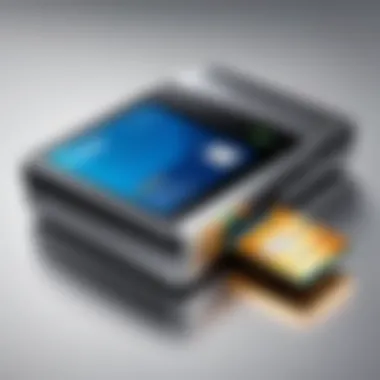
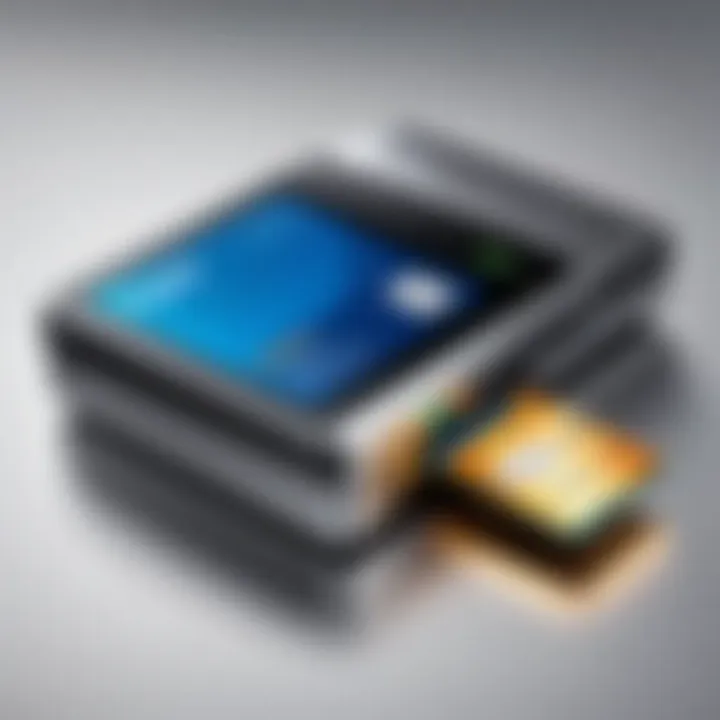
Error codes typically serve as a direct line of communication between your device and the user. To the untrained eye, they might appear as random assemblages of letters and numbers. However, these codes often indicate specific issues—whether it be connectivity hurdles, payment verification problems, or card compatibility issues.
Common error codes like “E001” or “E005” might pop up, each with distinct meanings. Here’s a rundown:
- E001: This code usually signifies a connection issue. It’s a clear indication that the reader can’t engage with the smartphone or tablet properly.
- E005: Often related to payment rejection, this error might indicate that a card has been declined due to insufficient funds or possible fraud.
Understanding these codes gives users a fighting chance to tackle them head-on rather than feeling baffled.
Step-by-Step Solutions for Common Errors
Upon encountering a specific error code, a methodical response is crucial. Here’s a structured approach that can help address the majority of common error messages linked to PayPal card readers:
- Identify the Error Code: Before taking any action, write down the error code. This will be your starting point.
- Refer to Documentation: Most manufacturers provide a guide or online resources. Check PayPal’s official site for specific error code meanings, recommendations, and fixes.
- Check Connections and Battery: Some errors are due to simple issues like loose cables or low battery levels. Make sure everything is plugged in tight and the device is charged.
- Restart the Card Reader: Like most electronic devices, a good restart can do wonders. Turn off the card reader, wait a moment, and turn it back on.
- Test with Different Cards: If the error persists, try using a different card. This can help to isolate whether the problem lies with the card itself or the reader.
- Update Software and Firmware: Make sure both the PayPal app and the firmware of your card reader are up to date, as this can solve compatibility and performance issues.
- Contact Support: If you’ve gone through these steps without success, reaching out to technical support is advisable. They have access to a broader database of errors and can provide tailored assistance.
"Understanding error messages is more of a roadmap than just a chance of luck. Skills in this area separate the proficient from the novice."
By handling error messages adeptly, users empowered with this knowledge can enhance their overall experience and maintain fluid transactions, solidifying customer trust in their payment systems.
Preventive Measures
To maintain a seamless experience with a PayPal card reader, it's essential to think ahead and implement preventive measures. While troubleshooting issues is important, being proactive can save time and energy. Taking care of your equipment not only prolongs its life but also ensures smoother transactions, ultimately leading to better customer satisfaction.
Regular Maintenance Practices
Regular maintenance is key to identifying potential problems before they escalate. This involves performing routine checks and cleaning of the card reader and its components.
- Wipe down the device: Dust and debris can accumulate over time. A gentle cleaning with a microfiber cloth helps keep the reader free from grime that could interfere with its functioning.
- Check physical connections: Ensure that cables and connectors are in good shape. A loose connection is often a hidden culprit for many issues.
- Inspect the card reader’s slot: Bits of dirt can easily get lodged into the card slot. Use a can of compressed air to blow out any debris carefully.
By incorporating these simple practices, you reduce the likelihood of encountering equipment issues down the line.
Keeping Software Updated
Software updates are more than just a hassle; they are a vital part of ensuring that your PayPal card reader performs at its best. Outdated software can lead to connectivity glitches, performance lags, or even compatibility issues with newer payment methods.
- Regularly check for updates: Make it a habit to check for both app and firmware updates for your card reader. This can typically be done within the app itself or the device settings.
- Automatic updates: If possible, enable automatic updates. This way, you don’t have to worry about forgetting to install necessary patches.
Staying current with software updates fortifies your card reader against potential vulnerabilities and enhances its functionality.
User Education and Training
An often-overlooked aspect of preventive measures involves ensuring all users are well-informed. This training can significantly reduce human errors that often lead to device malfunctions.
- Workshops or tutorials: Conducting training sessions for users can improve their confidence in operating the card reader efficiently.
- Create a quick-reference guide: A simple manual or guide outlining common issues and solutions can be invaluable. This could include what to do when a card isn't recognized or how to connect to Wi-Fi properly.
- Encourage sharing experiences: Whether through a forum or a dedicated group on platforms like Reddit or Facebook, sharing personal experiences related to troubleshooting can foster a community of support.
Educating users is an investment that pays off by reducing downtime and increasing overall satisfaction.
Implementing preventive measures not only contributes to a smoother payment process but also empowers users to effectively manage their devices. By prioritizing maintenance, keeping software updated, and ensuring proper training, you create a strong foundation for ongoing success with PayPal card readers.
User Experiences and Case Studies
As we navigate through the unpredictable waters of technology, user experiences become the lighthouse, guiding us through stormy seas. This section emphasizes the importance of real-life case studies and user-provided testimonies in resolving PayPal card reader issues. These experiences highlight not only common challenges but also emphasize practical, tested solutions that are often overlooked in manuals or guides. Users bring diverse perspectives, shedding light on nuances that technical documentation may gloss over.
Sharing user stories fosters a community of learning, where individuals can connect over similar frustrations, exchange tips, and celebrate small wins in the troubleshooting process. In essence, these stories add a rich layer of understanding to the otherwise clinical approach one might find in traditional troubleshooting guides.
Common User Experiences
In this sub-section, we delve into the variety of experiences users have faced with their PayPal card readers. Some users report incessant connectivity issues, describing moments of frustration as they try to process payments only to find their devices refusing to connect. Frequent complaints center around having to reset connections multiple times during peak business hours, leading to loss of sales and trust in the system.
Some anecdotes illustrate users experimenting with different pairing techniques or alternative mobile devices. A common reaction includes finding that a simple smartphone reboot often did the trick, while others discovered that their specific model of PayPal card reader required more frequent firmware updates than previously thought. These stories encapsulate the collective wisdom of users who, through trial and error, have turned troublesome situations into moments of learning.
"After weeks of wrestling with my Bluetooth connection, a fellow vendor suggested I try resetting the reader while my phone was in airplane mode. It worked like a charm!"
Effectiveness of Various Solutions
Analyzing the effectiveness of solutions shared by users reveals a treasure trove of unconventional fixes. Some users have found that keeping the reader updated to the latest firmware version reduced issues significantly, while others discovered that moving their phone closer to the card reader often led to a more stable connection. These experiences point to practical solutions that reflect a tendency towards hands-on troubleshooting.
The need for constant adaptation is evident as each user’s setup is unique. A vendor using the reader in a fast-paced environment may find one approach effective, while another operating in a quiet office has a different set of considerations. Thus, capturing a wide array of suggestions from other users can provide solutions that are flexible and customized rather than generic.
- Keep software updated as it often addresses known bugs.
- Experiment with different devices to gauge compatibility.
- Engage with community forums on platforms such as Reddit to gather real-life experiences and suggestions.
Exploring these experiences and their solutions not only empowers users but also lends credence to the idea that troubleshooting is often a communal effort, rather than a solitary task. By absorbing insights from fellow users, the journey through troubleshooting becomes a collaborative learning experience.
Ending
- Empowerment through Knowledge: Users who follow the troubleshooting steps laid out thoroughly can feel confident in their ability to tackle issues as they arise. This reduces reliance on external support and fosters self-sufficiency, a trait that is invaluable in today’s fast-paced technological landscape.
- Optimized Performance: As with many electronic devices, a little proactive maintenance can go a long way. By adopting regular upkeep practices, you can significantly prolong the lifespan of your PayPal card reader and ensure it’s firing on all cylinders when you need it most. This reflects a broader consideration of how well-maintained devices contribute to reliability.
- Practicality and Real-World Application: The real-world insights gleaned from user experiences serve to illustrate just how these troubleshooting measures can be effectively employed in various scenarios. Both novices and veterans will find value in case studies that highlight solutions that worked, alongside those that fell flat.
By synthesizing all the elements discussed throughout this article, you are now equipped with actionable insights to navigate the complexities of paying system issues better. Understanding and applying these techniques will ensure that your card transactions are smooth and successful, regardless of any electronic hiccups that may occur along the way.
Recap of Troubleshooting Steps
When it comes to troubleshooting your PayPal card reader, adhering to a systematic approach is crucial. Here’s a quick rundown:
- Checking Hardware Connections: Start by ensuring all connections are tight and secure. Loose cables or improperly seated devices can lead to recognition issues.
- Restarting the Card Reader: Sometimes, all it takes is a simple reset to eliminate minor glitches.
- Inspecting User Guide and Documentation: Familiarizing yourself with the device's manual can provide targeted solutions tailored to specific issues.
- Resetting Bluetooth Connection: If you’re facing connectivity problems, re-establishing the Bluetooth link can often do the trick.
- Charging the Device Properly: Ensure that the device is charged adequately to prevent power failures.
- Updating PayPal App and Firmware: Keeping the software up-to-date is key to ensuring optimal performance.
- Performing a System Reset: This is an option worth exploring for persistent problems, often restoring the device to factory settings.
- Consulting Technical Support: Ultimately, when all else fails, reaching out for expert help ensures that the issue gets resolved efficiently.
"In troubleshooting, sometimes we forget the simplest options that might solve the most complex problems."
Final Thoughts on Device Reliability
The reliability of a payment processing device extends beyond its initial purchase. It encompasses understanding, maintenance, and troubleshooting efficacy. Here are a few concluding points:
- Regular Maintenance Matters: Just like changing the oil in your car, keeping your card reader up-to-date and well-maintained is key to performance.
- User Education is Imperative: A well-informed user is less likely to panic when issues arise. Encourage practice in troubleshooting everyday problems.
- Adaptability to Future Technologies: With the landscape of digital payment evolving, ensuring your devices can adapt through updates and troubleshooting will keep you ahead of the curve.
In summary, taking ownership of your PayPal card reader’s performance and understanding its operation leads to smoother transactions and a more seamless business experience. When the inevitable hiccups do occur, having a treasure trove of troubleshooting skills will significantly ease the burden.



